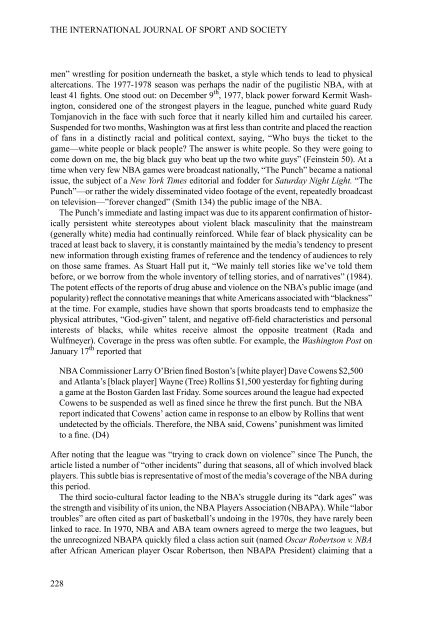Download - University of Minnesota
Download - University of Minnesota
Download - University of Minnesota
You also want an ePaper? Increase the reach of your titles
YUMPU automatically turns print PDFs into web optimized ePapers that Google loves.
THE INTERNATIONAL JOURNAL OF SPORT AND SOCIETY<br />
men” wrestling for position underneath the basket, a style which tends to lead to physical<br />
altercations. The 1977-1978 season was perhaps the nadir <strong>of</strong> the pugilistic NBA, with at<br />
least 41 fights. One stood out: on December 9 th , 1977, black power forward Kermit Washington,<br />
considered one <strong>of</strong> the strongest players in the league, punched white guard Rudy<br />
Tomjanovich in the face with such force that it nearly killed him and curtailed his career.<br />
Suspended for two months, Washington was at first less than contrite and placed the reaction<br />
<strong>of</strong> fans in a distinctly racial and political context, saying, “Who buys the ticket to the<br />
game—white people or black people? The answer is white people. So they were going to<br />
come down on me, the big black guy who beat up the two white guys” (Feinstein 50). At a<br />
time when very few NBA games were broadcast nationally, “The Punch” became a national<br />
issue, the subject <strong>of</strong> a New York Times editorial and fodder for Saturday Night Light. “The<br />
Punch”—or rather the widely disseminated video footage <strong>of</strong> the event, repeatedly broadcast<br />
on television—”forever changed” (Smith 134) the public image <strong>of</strong> the NBA.<br />
The Punch’s immediate and lasting impact was due to its apparent confirmation <strong>of</strong> historically<br />
persistent white stereotypes about violent black masculinity that the mainstream<br />
(generally white) media had continually reinforced. While fear <strong>of</strong> black physicality can be<br />
traced at least back to slavery, it is constantly maintained by the media’s tendency to present<br />
new information through existing frames <strong>of</strong> reference and the tendency <strong>of</strong> audiences to rely<br />
on those same frames. As Stuart Hall put it, “We mainly tell stories like we’ve told them<br />
before, or we borrow from the whole inventory <strong>of</strong> telling stories, and <strong>of</strong> narratives” (1984).<br />
The potent effects <strong>of</strong> the reports <strong>of</strong> drug abuse and violence on the NBA’s public image (and<br />
popularity) reflect the connotative meanings that white Americans associated with “blackness”<br />
at the time. For example, studies have shown that sports broadcasts tend to emphasize the<br />
physical attributes, “God-given” talent, and negative <strong>of</strong>f-field characteristics and personal<br />
interests <strong>of</strong> blacks, while whites receive almost the opposite treatment (Rada and<br />
Wulfmeyer). Coverage in the press was <strong>of</strong>ten subtle. For example, the Washington Post on<br />
January 17 th reported that<br />
NBA Commissioner Larry O’Brien fined Boston’s [white player] Dave Cowens $2,500<br />
and Atlanta’s [black player] Wayne (Tree) Rollins $1,500 yesterday for fighting during<br />
a game at the Boston Garden last Friday. Some sources around the league had expected<br />
Cowens to be suspended as well as fined since he threw the first punch. But the NBA<br />
report indicated that Cowens’ action came in response to an elbow by Rollins that went<br />
undetected by the <strong>of</strong>ficials. Therefore, the NBA said, Cowens’ punishment was limited<br />
to a fine. (D4)<br />
After noting that the league was “trying to crack down on violence” since The Punch, the<br />
article listed a number <strong>of</strong> “other incidents” during that seasons, all <strong>of</strong> which involved black<br />
players. This subtle bias is representative <strong>of</strong> most <strong>of</strong> the media’s coverage <strong>of</strong> the NBA during<br />
this period.<br />
The third socio-cultural factor leading to the NBA’s struggle during its “dark ages” was<br />
the strength and visibility <strong>of</strong> its union, the NBA Players Association (NBAPA). While “labor<br />
troubles” are <strong>of</strong>ten cited as part <strong>of</strong> basketball’s undoing in the 1970s, they have rarely been<br />
linked to race. In 1970, NBA and ABA team owners agreed to merge the two leagues, but<br />
the unrecognized NBAPA quickly filed a class action suit (named Oscar Robertson v. NBA<br />
after African American player Oscar Robertson, then NBAPA President) claiming that a<br />
228

















